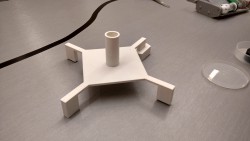This past week has been yet another successful one for Jim and I. We’ve been making progress on the mounting solution for our DHT22 sensors. We wanted at least three sensors picking up data from different heights, so Jim 3D printed a series of parts to mount a 3/4″ dowel rod onto the Roomba’s body. We’re still fine tuning how everything will fit together, but he has a pretty good prototype right now. Next week when we get our fancy new 3mm RFID tags and a USB hub for the Pi Zero, he’ll be working to find a finalized interior setup for all the electronics in the modified dust bin
.
On the software side of things, I’ve still been fine-tuning our line-following logic as well as preparing for the use of RFID tags. As Jim said in an earlier post, we won’t be using black electrical tape as our guide, but rather the cracks in between the tiles themselves. This leads to the issue of the crack being slightly smaller than the distance between the IR line sensors, so there might be readings where the line doesn’t show up at all. I think I’ve found a good balance between speed, turn correction, and the length of time it will time out at if it hasn’t found a line.
Before I left on Wednesday, I ran a little program to drain the Roomba’s battery completely, and to measure the amount of time it takes to do so. From what I found, the battery drains (with the wheels moving, and the OI in Full) at a rate of approximately 1% every 4.75 mins. This morning I ran the same program, except to measure how fast the Roomba charges. I found that with the OI in Passive, the Roomba charges at a rate of 1% every 1.5 mins. We’ll use this information when planning the route the Roomba will follow.
Next week, Eric and I will be looking into the possibility of using Slack as the method of turning off the Roomba for server maintenance as well as sending alerts that the Roomba might be lost, running low on battery, etc.




